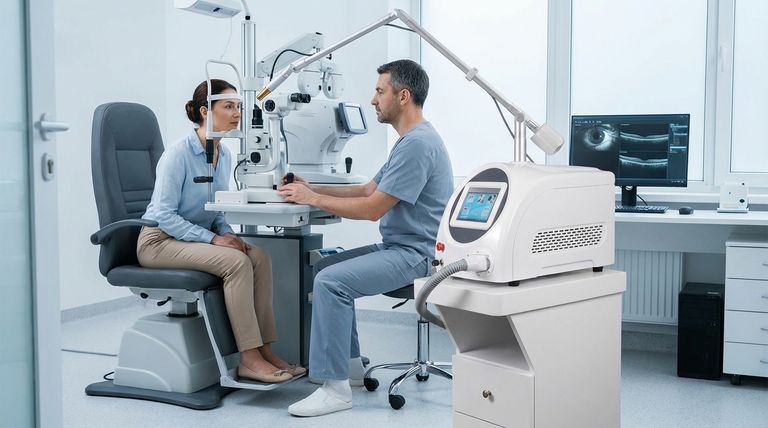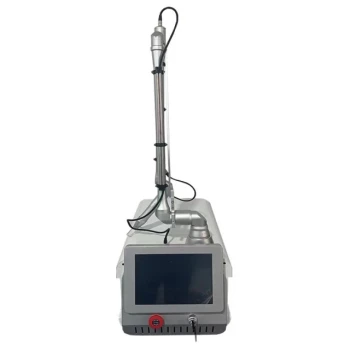The primary precaution you must take during a YAG laser procedure is simple but critical: remain perfectly still and keep your focus on the target light as directed by your ophthalmologist. While you may hear clicking sounds or see flashes of light, the procedure is painless and very brief. All technical safety measures, such as aiming the laser and applying the correct energy, are entirely managed by your doctor; your cooperation is the key to ensuring the procedure is swift and effective.
A YAG laser capsulotomy is a remarkably safe and automated procedure. Understanding the simple, cooperative role you play—before, during, and after—is the most effective precaution you can take to ensure a smooth, anxiety-free experience.

The YAG Laser Procedure: A Step-by-Step Guide
To feel fully confident, it helps to understand the entire sequence of events. The procedure is designed for maximum safety and minimal patient action.
Before the Laser: Preparation
Your preparation on the day of the procedure is minimal. Your doctor's office will administer eye drops to dilate your pupil, which allows the ophthalmologist a clear view of the lens capsule they need to treat.
These drops will make your vision blurry and increase your sensitivity to light for a few hours. A numbing drop may also be applied to ensure comfort.
During the Laser: Your Role
Once your pupil is dilated, you will be seated at the laser machine, which looks similar to the equipment used for a standard eye exam. You'll place your chin on a rest to keep your head stable.
Your only responsibility is to hold still and focus on a light as instructed. The ophthalmologist uses a special contact lens placed on your eye to keep it open and precisely aim the laser. The actual laser application typically lasts less than a minute.
Immediately After: The First Hour
After the laser is finished, your vision will still be blurry, primarily from the dilating drops. It is standard practice for your doctor to check your eye pressure within an hour of the procedure to ensure it remains stable.
You will not be able to drive yourself home. The combination of dilating drops and the initial change in your vision makes it unsafe. You must arrange for transportation.
Understanding Recovery and Potential Side Effects
While the procedure is straightforward, knowing what to expect during recovery is crucial for peace of mind.
Post-Procedure Care and Restrictions
As the reference material states, you can typically resume normal activities right away. The key restriction is to avoid driving on the day of the procedure. You can usually drive the following day.
Most patients do not require prescription eye drops after the laser, but your doctor will advise you if your specific case requires them for managing inflammation or eye pressure.
Common, Temporary Side Effects
It is very common to notice new "floaters" in your field of vision after the procedure. These are tiny, harmless fragments of the lasered capsule that will typically settle or dissolve over the next few weeks.
Your vision may take a few days to fully clear and stabilize as your brain adapts. Some mild light sensitivity can also persist for a day or two.
Potential but Rare Complications
The YAG laser capsulotomy has an exceptionally high safety profile. However, as with any medical procedure, there are rare risks. These include a temporary increase in eye pressure, inflammation, or, very rarely, retinal swelling or detachment.
Follow-up appointments are scheduled to monitor for these uncommon issues and ensure your eye is healing perfectly. Attending this follow-up is a critical safety precaution.
Making the Right Choice for Your Goal
To ensure you are fully prepared, focus on the aspects of the process that align with your primary goal.
- If your primary focus is safety during the procedure: Trust that your ophthalmologist controls all technical variables; your only job is to remain still and follow their simple instructions.
- If your primary focus is a smooth recovery: Do not drive on the day of the procedure, and be patient with common side effects like floaters, as they typically resolve on their own.
- If your primary focus is excellent long-term results: Attend your scheduled follow-up appointment to confirm your eye pressure is stable and your vision has cleared as expected.
Ultimately, a YAG laser capsulotomy is a standard and highly effective procedure designed to restore the clarity of your vision with minimal disruption.
Summary Table:
| Precaution Phase | Key Action | Why It Matters |
|---|---|---|
| Before | Arrange transportation | Dilating drops cause blurry vision, making driving unsafe. |
| During | Remain perfectly still | Ensures the ophthalmologist can precisely target the lens capsule. |
| After | Attend follow-up appointment | Monitors eye pressure and healing to catch rare complications early. |
| Recovery | Be patient with floaters | Common side effect; fragments typically dissolve within weeks. |
BELIS specializes in professional medical aesthetic and ophthalmic laser equipment, serving clinics dedicated to patient safety and outstanding outcomes. If you are a medical aesthetics clinic or premium beauty salon seeking to enhance your service offerings with reliable, state-of-the-art technology, contact our experts today to discover how our solutions can support your practice's growth and patient care standards.
Visual Guide

Related Products
- Q Switch Nd Yag Laser Machine Tattoo Removal Nd Yag Machine
- Clinic Use IPL and SHR Hair Removal Machine with Nd Yag Laser Tattoo Removal
- Pico Picosecond Laser Machine for Tattoo Removal Picosure Pico Laser
- Diode Laser SHR Trilaser Hair Removal Machine for Clinic Use
- Hydrafacial Machine Facial Clean Face and Skin Care Machine
People Also Ask
- Is Q-Switch laser safe for skin? Achieve Precise, Non-Invasive Skin Rejuvenation Safely
- What are Q-switched lasers commonly used for? Remove Tattoos & Pigment with Precision
- What are the side effects of Q-switch laser? A Guide to Safe, Effective Treatment
- What are the disadvantages of Q switching? Trade-offs in Pulse Control, Cost, and Beam Quality
- Is Q Switched Nd:YAG laser good? The Gold Standard for Tattoo & Pigment Removal



















